
Integrated amplifiers. We all know what they are, right? The classic definition involves having a power amplifier and a preamplifier integrated into the same chassis. Hence the name. It used to be very straight forward - you could walk into a brick and mortar store, or browse an audio catalog/website, and easily see the distinction between power amps, preamps, and other devices such as DACs. When grouped together each category had generally the same capabilities and features.
Nowadays things aren't so simple. Many "integrated" amps now feature one or more digital inputs, thus blurring the line between integrated amp and DAC. I see reasonably priced options from Cambridge and Marantz, step up models from Rotel and Parasound (in their Halo range), and true high-end designs from the likes of McIntosh and Devialet, all of which have a full selection of both digital and analog inputs. Some of these devices even have headphone jacks, giving them potential for true all-in-one status. Add a computer (or disc transport if you want to be old school), speakers and/or headphones, and you're all set.
Unfortunately, the headphone jack on most of these types is rather questionable. I can forgive that sort of thing on a Marantz PM6005 or a Cambridge Audio 651A, both of which clock in at well under a grand. The issue is more with expensive models - users who pay two or three thousand dollars on something upscale may have the gall to think they have correspondingly high-quality headphone amplification on board. But I rarely come across an integrated with a headphone out exceeding the performance of, say, a $250 Matrix M-Stage dedicated headphone amp. Not saying it doesn't exist... it's just exceedingly rare. Interestingly enough, a quality headphone outputs seemed a lot more common place on vintage devices from Pioneer, Sansui, and other. Seems we've gone downhill - on the whole, I'd say the headphone side of these things could use some serious work.
But wait - don't most DACs these days have built in volume control? They sure do. That opens up the field quite a bit right? Stuff like the Benchmark DAC 2 variants, Anedio D2, and even the affordable Yulong Audio D200 - all have plenty of digital inputs as well as preamp capabilities either in the digital or analog domain. And on the plus side, these have far more credible headphone outputs. We trade out the speaker amp section though, and we don't always get analog inputs or remote volume control. Plus a lot of people think these types of DACs don't do an adequate job driving an amplifier directly. There's a large number of people I've spoken with who find them too sterile. Squeaky clean. Lacking in "grunt" to use a technical term. It's not necessarily a volume issue but more a problem of tonal density and richness. Many feel that adding a dedicated preamp to the mix does wonders for adding realism and weight to the final result. Same DAC, same amp, same speakers.... the weak spot must be the DAC and its ability (or lack thereof) to drive those amps directly. I can't say my experience lines up perfectly with this theory but I might agree on a case by case basis. One doesn't have to browse audio sites very long to find pro reviewers and consumers alike who agree with this assessment and thus hang on the their preamps.
Stay with me here, because I've got a point to all this discussion. Say you're an audio designer and you want to offer a really high quality all-in-one device. You can't make it huge so you've got to pack everything in a reasonably sized enclosure. A superb DAC is an absolute must - you've already got a reference caliber DAC in your stable, so you end up using that as a reference and packing in as much of that technology as possible. Since this is HeadFi, you're extremely concerned about the headphone amp quality as well. The usual simplistic opamp output or voltage divider from the speaker amp simply won't do. Luckily you already have an exceptional headphone amp in your lineup, so again you try to cram most of that design in this magical box as well. This leaves you with very little room for anything else. You make sure the preamp section is up to snuff, with analog volume control via motorized potentiometer so a remote can be included. You provide a reasonable amount of inputs and outputs - as many as will be allowed given your size constraints. And that's pretty much all we need right? Wait, we forgot the speaker amplification section....
The product in question does exist. It's called the CMA800i from Questyle Audio Engineering. Maybe I'm just overly concerned with semantics, but for some reason I'm really intrigued with what Questyle has going on here. It's essentially a modern integrated amplifier with a focus on digital inputs rather than analog, but it swaps out the speaker amplification for a very potent headphone stage based on the highly regarded CMA800R headphone amp. The DAC stage is based on their CAS192D which again is known for being extremely high quality. The logic here is that most of us are primarily concerned with headphone amplification and wish to build a system around that aspect. And yet we may want to add speakers to the mix at some point as well. The CMA800i makes a fantastic preamp for dedicated amplifiers or active speaker systems, and fits right in at the heart of a semi-complex system in a way that most DACs can't - even those modern DACs with volume control on board.



The CMA800i ($1,999) comes very close to being a CMA800R headphone amp ($1,499) plus a CAS192D DAC ($1,499) stuffed in one box. Each design is very well represented with minimal compromise despite having less real estate. We lose a few inputs on the digital side, and we don't get the option of doubling up for a dual mono amp setup as we do with the dedicated CMA800R. We also lose the display on the DAC side, making do instead with LED indicators to show filter selection. In exchange we get remote capabilities and output voltages more in line with a proper preamp than with a regular DAC. Ever notice most DACs, including those with volume controls, go to around 2V via RCA outs, and 4V from XLR? That's plenty for a lot of situations, but it's also significantly less than many dedicated preamps. Those creatures commonly top out at 7V or 8V or even higher at times. Along those lines, the CMA800i does 4.3V via RCA out and 8.6V on XLR. That may end up being more than needed but then again we can simply lower the output in those cases. On the flip side, a DAC with 2V RCA outputs cannot go any higher, and thus may end up being a poor match with certain amplifiers depending on the voltage gain involved. Try to pair that DAC with an amplifier having a mismatched input sensitivity, and you won't be able to drive the amp to its full unclipped power. This is more common with higher power amplifiers but you just never know - to make matters worse, this number is not always easy to find with all amps. Bottom line - the higher output option covers all the bases which is why we see it more often in "true" preamp devices.

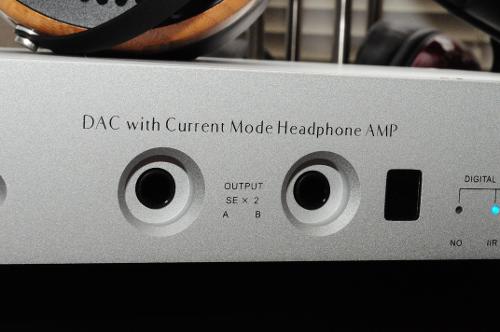

Specifics
The CMA800i has just enough going on to make it fit in most systems. On the input side we get a high quality USB input with 24/192 PCM capabilities and Questyle's proprietary TrueDSD implementation which handles DSD64 and double data rate DSD, aka DSD128. We also get a coaxial SPDIF input with the usual 24/192 PCM status. There's also a single RCA analog input on the off chance you want to use some other source, or perhaps a vinyl setup (separate phono preamp required, obviously). For outputs we get RCA and XLR analog outs as well as a coaxial SPDIF output which forwards the transcoded USB data, just in case someone had a use for that. And of course the pair of 1/4" headphone outputs on front. Counting the headphone jacks, we get a total of 3 inputs and 5 outputs split fairly evenly between digital and analog. Not the most feature packed integrated I've ever seen in this area, but it should do the trick for most systems.

To dig deeper into the specs: Digital inputs are converted to analog by Wolfson's flagship WM8741 with your choice of two custom digital filters. TrueDSD mode deactivates any digital filtering as Questyle prefers to handle that in the analog domain. A proprietary USB receiver handles incoming signals - Questyle works with a famous chip maker to customize their solution, tweaking it to their specific needs. You'd probably recognize the source chip if I named it, as it is used in several very popular DACs on the market right now. Like the CAS192D and other quality USB DACs, CMA800i features three independent custom low phase-noise clocks. It also uses a proprietary chip which looks to me like an FPGA - as was the case with their CAS192D, Questyle doesn't want their design completely revealed. How mysterious. Again we get a Wolfson WM8805 SPDIF receiver, Plitron toroidal transformer, and extensive voltage regulation with independent power supplies for different functions. And of course the device uses the proprietary Current Mode Amplification which I discussed in THIS review. It's all pretty much what I've come to expect from Questyle based on my experience with their gear. And notice how many times I used the words "custom" and "proprietary".

WM8805 digital receiver
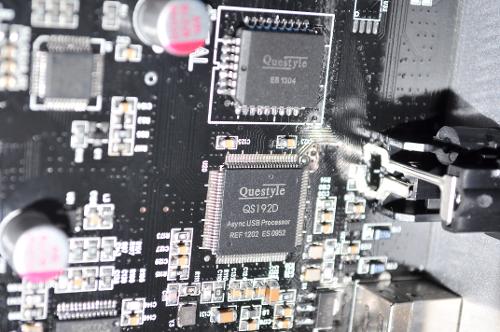
Proprietary Questyle chips
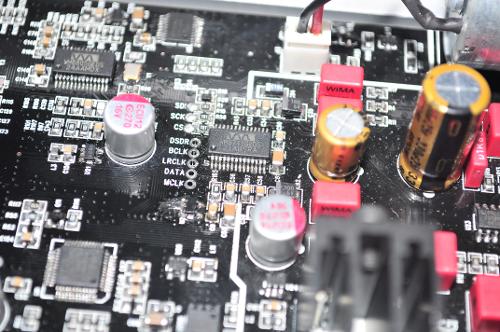
WM8741 DAC chip

Headphone amp section
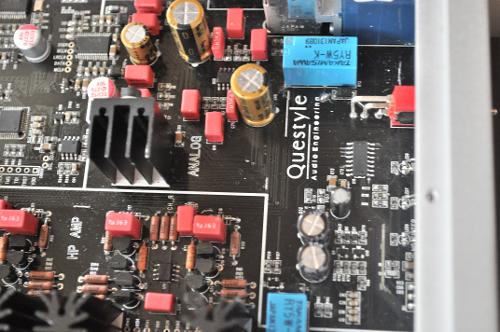
Analog section

Digital section
The motorized Alps RK27 potentiometer is controlled by a remote that initially looks somewhat low rent, but is actually fairly nice to use. Contrast it with some of the competition who loves using giant slabs of metal for their wands - confidence inspiring, but not very fun to use considering the weight and the tiny buttons. This particular remote is nearly identical to the one used by B.M.C. for their highly-regarded PureDAC device.

Use
Rather than using my usual reference headphone rig, I instead took the CMA800i straight to my 2-channel setup. I fed it with an HP Elitebook laptop over USB - it's a reasonably modern device using a Haswell i7, 16GB RAM, and large SSD. I also pulled in music from my 8TB NAS, ranging from Redbook quality to DSD128, and used JRiver Media Center for playback, controlled via iPad Air using JRemote. I occasionally used a YBA Design WM202 as transport for the coaxial input. XLR outputs went to a pair of Ghent Audio M500P monoblocks using ICEpower technology, which in turn fed a set of Sjofn Clue loudspeakers. Of course, I also used the headphone outputs with a wide variety of headphones, including LCD-2, HD800, T1, HE-500, and many more. Ancillary equipment included a CablePro Revelation power strip, Cabledyne Silver Reference interconnect and digital, Cabledyne Copper Reference AC, and Charleston Cable Company Auric speaker cables.



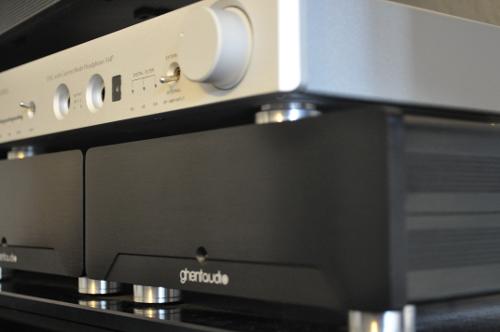
The last few dedicated preamps I've had in this system were significantly more expensive than the CMA800i. I was using a Meridian G02 for a while, and prior to that was a Jeff Rowland Design Group Capri. I happen to still have both on hand for comparisons. Both of these devices cost roughly double the CMA800i and both are pure analog only..... so the value is definitely tilted towards the Questyle device when we consider features. On build quality, the Capri has the usual Rowland aesthetic, and the Meridian is quite striking as well. The CMA800i is very well built and rather handsome in general but it does suffer a bit from having too many knobs, switches, lights, etc, all over the front panel. Still, this is a matter of style, not a strict downgrade. So that leaves us with sound quality - should spending more for a device with less features net significant SQ improvements? In this case: not particularly.
First off, I found the Capri to be outclassed by the other two models in this particular system. It just sounded a little veiled and soft in comparison. I initially had thought this was my Sjofn monitors not being detailed enough - but after swapping to the Questyle I see that was not the case.
The Meridian sounded very, very similar to the Questyle. In fact I don't think I could reliably tell them apart in this context. I used the CMA800i as DAC to feed the G02 to keep things fair, and I just didn't spot any significant areas of variation worth mentioning. This speaks very highly of the Questyle as the G02 is known to be a top notch preamp. Of course, there are more inputs and outputs and the famous Meridian name to consider.... Interestingly, when I swapped out the Ghent Audio ICEpower monoblocks for a Parasound Halo A21, the Rowland was back in the mix, sounding a lot more similar to the others. I don't know why it was such a poor match the first time around - especially considering Rowland makes ICEpower amps themselves. This shows me once again that you can't just throw together a system and expect greatness, even if each individual component is reasonably well regarded. Synergy is definitely at play in certain combinations, and a lack of synergy in others.
I later brought the three devices to my main headphone rig and used each to drive the Questyle CMA800R monoblocks (which work best with volume controlled via preamp or DAC) feeding a balanced HD800. This combo is extremely resolving and detailed, far more so than my speaker rig, and it helped differentiate the character of each device. Turns out they do have differences. The Questyle sounded a bit thinner than the Meridian in the lower midrange, making it less punchy and dynamic. But it did seem more revealing of microdetails and subtle nuances found in excellent recordings. In a word, the Meridian was more "dramatic" and the Questyle more "refined". The Rowland seemed more midrange focused with a very lush, involving presentation, but less extension than the other two on top and bottom. This time around I did find it enjoyable - it's interesting how much of a difference a preamp can really make in shaping your final sound quality. I hesitate to pick an absolute winner of these three, which again is complimentary of what Questyle has accomplished.
I imagine some readers wonder when I'll get to the point. "Forget all the semantics about integrated amps, or preamplification, output voltages, Current Mode Amplification, blah blah blah. I just want to use this as an all in one DAC and headphone amp. I don't care what you call it. How does it sound with headphone X, Y, and Z?" I can understand that line of reasoning so I'll cut to the chase... or at least, try not to ramble so much.
I continued with the HD800 which had paired so well with Questyle's dedicated headphone amps. Sure enough, I got very impressive results straight from the CMA800i. This was an extremely transparent, clean, fast combination that did a bang up job with quality material, and really showed how poorly done many newer recordings are. I loved going through my reference catalog playing Kind of Blue, Dvorak, Haydn, Jacintha, and a bunch of others from Channel Classics, Reference Recordings, Harmonia Mundi, Blue Coast, and other fine labels. If we define "realism" as the ability to hear deep into the recording, including subtleties and microdetails and all those little things.... the CMA800i driving HD800 is up there near the best I've ever heard. There was, however, a very stark contrast when I played some modern overcompressed music on this system - as much as I enjoy Further Seems Forever, Infected Mushroom, BT, Mastodon, etc, a lot of that stuff is borderline unlistenable on an HD800 with a really transparent system. Realistically - if you play a lot of poor recordings you shouldn't be using an HD800 in the first place. An LCD-2 will do a much better job. But if you insist on an HD800 and you spend a lot of time with those types of recordings, none of the Questyle gear is really a good match for you.
The Grado PS500 is my favorite modern Grado (I have yet to hear the new "e" version) and the CMA800i drives it with fantastic results. It has all the fun I enjoy from the Grado signature while minimizing (though not quite eliminating) the drawbacks. I broke out my Steve Hoffman remasters of Metallica's Ride the Lightning and Master of Puppets and played them all the way through, marveling at how we went from gems like this to Death Magnetic in just two decades. The CMA800i does nothing to stifle the signature Grado "bite" or midbass warmth, and when I tried a borrowed set of SR-325is I did not like the result at all. But again that comes down to the headphone itself - CMA800i is not one of those devices that "improves" a Grado by smoothing it or otherwise changing it. You get the true Grado sound, like it or not. I don't normally consider myself a huge Grado fan but this experience has inspired me to seek out a vintage RS-1 or HP-1000, as well as try something from the new "e" series.
I went back and forth with the Audeze LCD-2 and HiFiMAN HE-500 - both are well done, but the LCD-2 sounds better for my preferences in this particular application. The speed and resolution of the Questyle really complements the somewhat laid-back LCD-2 signature, and while HE-500 is still enjoyable it ends up being a little on the bright side at times. Both models have nice bass impact, and both sound very open and fairly expansive. But it's that top end that really differentiates them for me - the HE-500 seems to have a mid-treble peak that gets fatiguing after a short time, and the CMA800i certainly does nothing to hold it back. I have other amps which favor the HE-500 but in this case Audeze takes the win. I did try the HiFiMAN HE-6 and got mixed results - it's not terrible, certainly still listenable, but also very obviously missing out on the supposed world-class performance of that headphone. This was the single largest difference between the CMA800i and the dedicated CMA800R - the power rating doesn't change by much, yet somehow the integrated model loses the ability to shine with this admittedly difficult challenge.
If you've read my thoughts on the CMA800R, you'll recall how it was pretty much a no-go for sensitive in-ear monitors. There's an ever-present hiss, and the gain is just way too high, leaving very little usable room on the volume knob. No big deal, a lot of big amps have issues with IEMs. So I wasn't expecting anything better with the CMA800i. But to my surprise, it actually works much better this time around. Perhaps Questyle got the memo that IEMs and custom IEMs are big business now. The gain is still fairly high but at least I can get to 9 or 10 o'clock on the dial before it gets too loud. And the background is nice and clean - no hiss to be found. As I turn up the volume (with no music playing) I do hear a faint but increasing bit of noise, but it's well outside the bounds of what I could tolerate while the music plays. So I was able to successfully enjoy my Noble Kaiser 10, JH Audio JH13Pro, and other top custom in-ear monitors, in a way I never could on the dedicated CMA800R. I consider this a big deal because I love CIEMs and use them frequently at home rather than just on the go like some people do.
After all the swapping of preamps I did earlier, I was already spending more physical effort on this review than usual. But my work was not yet done. I figured the best way to really do justice to this device was to compare it with the stand-alone amp and DAC models from Questyle. To make matters even more complex, I wanted to see if the CMA800i was equally strong in all aspects. So I mixed and matched CMA800i with CMA800R and CAS192D to get a sense of how each function stacked up to the reference. To make a really long story slightly less long, the CMA800i comes pretty darn close to the individual components. Maybe 90%, give or take. The individual components add up to $3,000, yet the CMA800i sells for $2,000 - a significant savings considering the small compromise involved. Aside from the previously mentioned HE-6 challenge, the amp side really only stumbles when asked to handle exceedingly complex material, and even then only by a small amount. Unless you're a fan of dense symphonic works or certain jazz, the differences are small enough as to be nearly indistinguishable.
On the DAC side, the stand-alone model again holds a very tenuous advantage. I confess I do miss the handy OLED display, and I think the CAS192D looks quite a bit nicer due to the clean front panel. I also miss the ability to track incoming sample rates - the integrated unit has LED indicators to differentiate PCM from DSD signals, and that's it. The CMA800i only has two digital filters but the IIR option is still present and that's really all that matters as it was my favorite out of the original five choices. Again, when using really dense, really high-res material I might notice some worthwhile improvement with the dedicated unit. Instrument separation and layering is somewhat better and the sound is more coherent overall. But much of the time it's hard to tell them apart.
As with the CAS192D, this device sounds absolutely ravishing when playing DSD. I don't know if I necessarily agree with Questyle's negative assessment of the DoP process used by most other devices, but I have to admit - their particular handling of DSD is among the best sounding I've yet heard. While some DSD material is no better than Hi-Res PCM (and indeed many "DSD" releases are simply repackaged PCM anyway), some of it actually does live up to the hype. If you have an adventurous taste in music and especially if you enjoy jazz and classical, it's definitely worth exploring.
Any complaints to speak of? I've already mentioned the front panel looking somewhat busy, and even then it doesn't contain every bit of info I might want. I'd also like to see a Toslink input to replace the coaxial SPDIF output - the USB to SPDIF conversion makes sense on their more affordable Q192, but I just don't see much use for that function in a device of this caliber. And as with CAS192D, DSD playback is limited to JRiver on a Windows system at the moment which is a potential downside for some users. And lastly, the filters can only be switched by using the remote. These minor complaints are really the worst I can come up with.... and none of them are serious problems. Then again it helps to recall the Questyle signature across the board - it's fast, detailed, and very accurate, which isn't always the best match for every situation. Listeners wanting a warm, creamy midrange or mellow highs will not particularly like this presentation. You've been warned.
Conclusion
The Questyle CMA800i is a very clever device. Whether we consider it a cutting edge integrated with a focus on digital inputs and headphone amplification, or just call it an all-in-one headphone amp/DAC/preamp device like so many others on the market, the end result is the same - a versatile device with exceptional sound that can take a central role in most any audio system. When I recall how much I like the individual Questyle flagship components, and then consider how close the CMA800i comes to that level of performance, for much less cash... it's an easy recommendation for anyone seeking extreme levels of accuracy and refinement. It even does some things better, like playing well with sensitive IEMs.
There's a lot of competition in this space. The BMC PureDAC is excellent and costs a bit less, and then there's the Benchmark DAC 2 and Grace Design M920, and probably others that I'm missing. Unfortunately I didn't have any of those here for direct comparisons. I will say the BMC falls on the warmer, smoother, more "analog" side of the spectrum, making it a very different animal than the CMA800i. Still, I don't recall any of these knocking me out in ways the Questyle does not. Most others tend to start as a DAC and then add a headphone out as a sort of bonus - Questyle starts with a genuine high-end amp, avoiding that "afterthought" syndrome.
I hope Questyle continues to innovate, and I hope even more that they get more exposure in the USA. I anticipated more online distribution but apparently they want to go in a different direction, using brick and mortar stores instead. That wouldn't necessarily be my choice but hey, nobody asked me. If you find yourself intrigued and want to know where to find one of these devices, contact Questyle North America rep Bruce Ball to find out where to look.

Driving dual CMA800R monoblocks and feeding the HiFiMAN HE-6
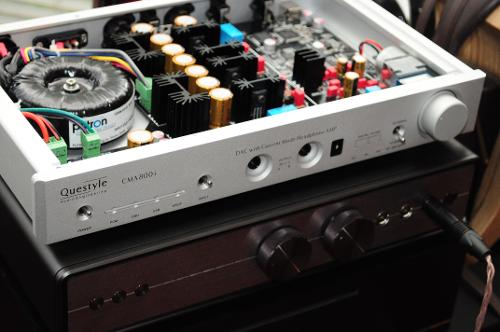
Topless

With YBA CD transport

More Monoblock action

More eye candy
 With Ghent Audio monoblocks in my speaker rig
With Ghent Audio monoblocks in my speaker rig
